Now that you have the vehicle (Confluence) and the fuel (Jira Software), it’s time to put the gears in drive and optimize your team’s agile project management lifecycle. These two powerhouses provide robust capabilities built to grow and scale with your enterprise. Whether you’re a seasoned agile expert, or just getting started, the features and templates offered in these tools can help your team unlock the power of agile.
Confluence and Jira integrate seamlessly to save your team time, improve the issue resolution process, and transform the way that your team collaborates on projects. Individually, they provide great benefits in their own way. Together, they are an unstoppable force that will help your team bring the agile vision to life.
Let’s dive into how to put the two in action for every stage of your team’s sprint.
The definition of ‘ready’ and ‘done’
The sprint plan is created by the team members and is unique to every team. Planning involves creating the product backlog and determining the scope of work that is feasible for all team members during the sprint. Confluence and Jira work hand-in-hand to describe the goal of the sprint and visualize how your team will start working towards it.
Sprint planning in Jira Software
Jira Software supports any agile methodology, including scrum, kanban, mixed methodologies, and more. Jira is the single source of truth for all the work your team needs to deliver during a sprint. With pre-configured templates to choose from that are fully customizable and endlessly agile, Jira Software helps set your team up for success.
Jira has built-in workflows (to-do, in progress, and done) that you can use without needing to make any changes, or you can start fresh and create your own. To further customize your workflow, simply create an additional status that will reflect the needs of your team. For example, adding an ‘in review’ status indicates that there is a need for quality assurance before the task can be marked as completed. You can make Jira reflect how your team works as much (or as little!) as you like.
Before diving into the planning process, the best practice is to establish the definition of epics, stories, and labels within your team. This helps organize your team’s plan and creates a clear roadmap for getting started with the tools. Using checklists in Jira also creates an additional layer of accessibility and visibility for your team’s task definitions.
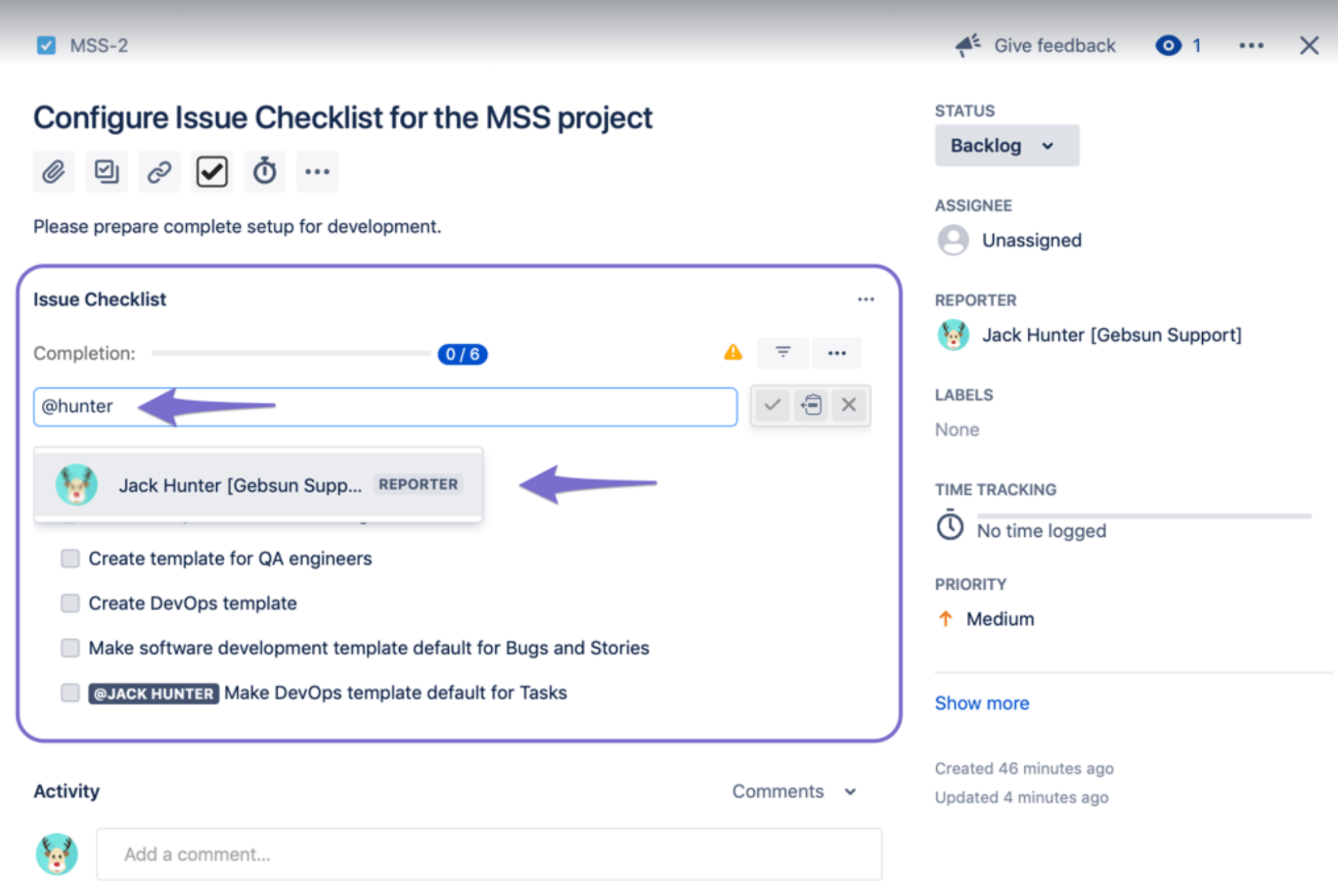
The Jira Issue Checklist App can automatically add definition checklists to each story. Splitting Jira stories into lightweight to-do items will streamline the process even further as each task is clearly and easily defined in scope. Keep in mind that the definitions will change over time as your team continues to learn, grow, and improve.
Sprint planning in Confluence
Once your team creates best practices in Jira, it’s time to start creating documentation for your agile projects. The best way to manage a project is to create a project space for all relevant knowledge in Confluence. A project space acts as a single point of contact for the nitty-gritty details of your project, allowing your team to easily access the information.
It’s important to create an organized and structured hierarchy in Confluence. Here are two ways that your team can organize the documentation:
- Create a space for each functional team and pages for each major project or initiative.
- Create a space for each project and pages for each release cycle or launch.
Confluence offers over 80 templates to help maintain agile practices and keep everyone on the team up-to-date. The sprint planning template is a great blueprint to kick off new projects and define sprint goals.
Additionally, the sprint retro template holds your team accountable for changes that should be made in the next sprint. From strategic planning to product requirements, to status updates, Confluence has a template that’s sure to be a perfect fit for your project.
Joining forces
Now that your team is set up with Jira and your Confluence documentation is in order, you’re ready to link Confluence pages with Jira projects. This provides your team with all of the context, information, and traceability they need to successfully get started on their tasks, without the hassle of jumping between multiple applications.
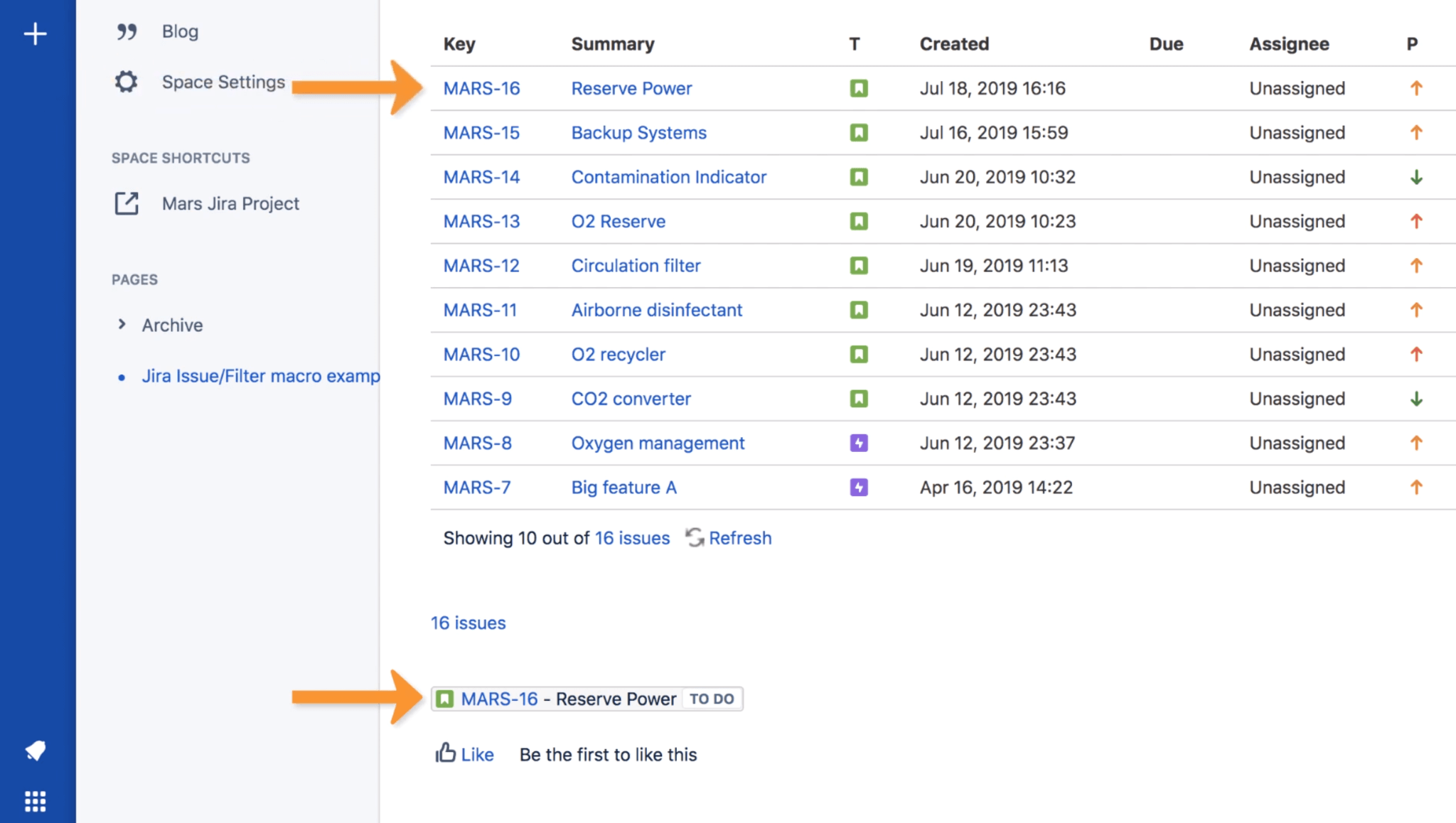
In Jira, you can easily add Confluence pages directly within the software. In Confluence, connect your project spaces directly to Jira. Now you have a link between all associated pages and documentation!
Pro tip: you can also take quick action for any missing pieces of work by creating tasks directly in Confluence! Simply highlight the text within your documentation, and the integration will populate the text into a Jira work item.
Confluence and Jira will set your team up for success by creating an accessible, streamlined approach to your agile process. The software ensures that your team is on the right track for an optimal agile sprint cycle by eliminating any and all issues — except for the ones you create.
The sprint planning stage
The sprint planning stage provides a solid foundation for your team’s agile process. At this stage, the product backlog should be up-to-date and refined to provide clarity. Note that how well you went through the refinement stage will determine the success of your sprint planning. That is why gaining as much up-front clarity as possible is crucial to help everyone get the transparency needed to get started on the work.
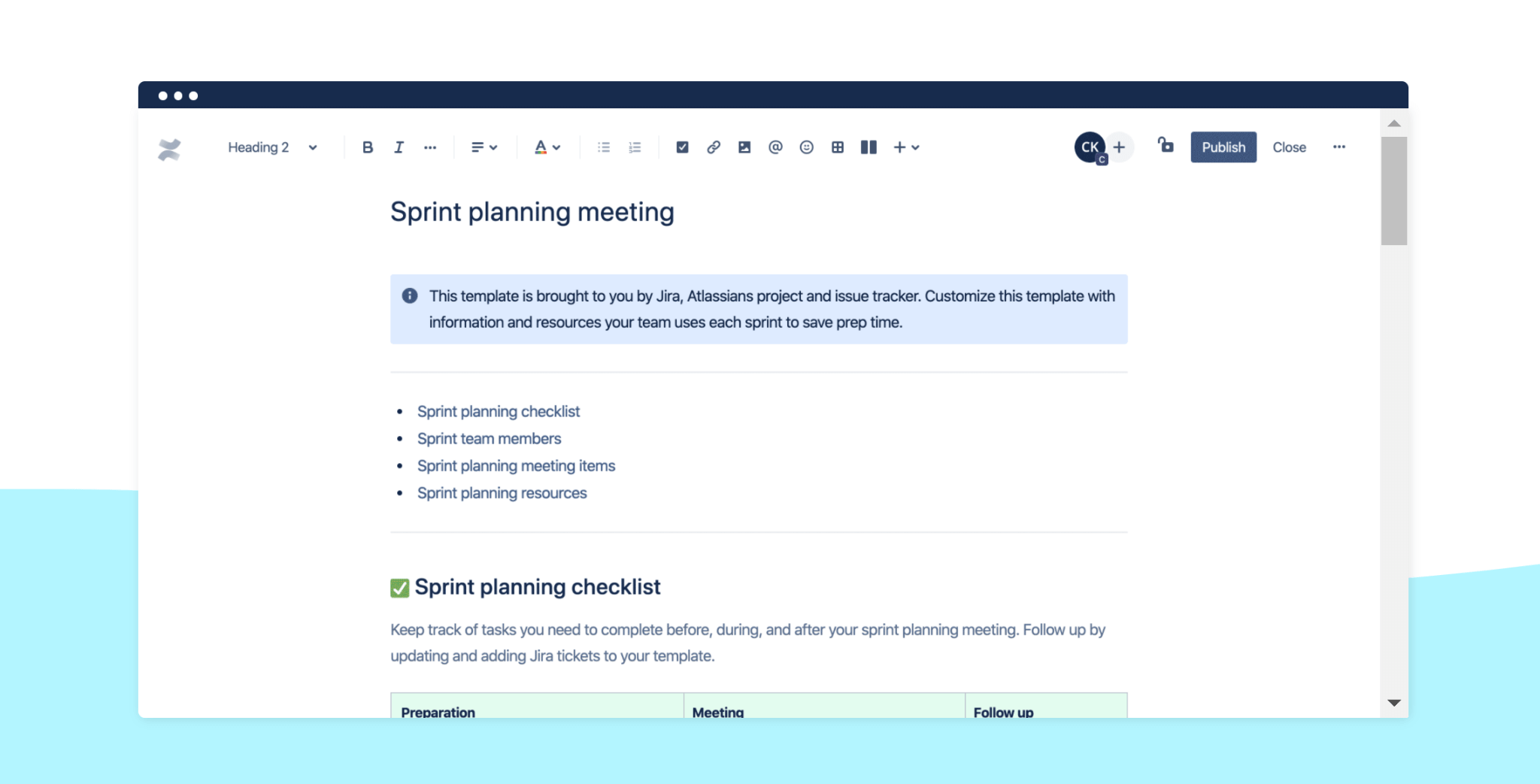
As previously mentioned, use the Sprint Planning Meeting Template in Confluence to help your team optimize the planning process. Here are four steps to get you on the right track:
- Start your sprint planning meeting by following up on any open questions from the previous sprint before tackling the current sprint goals.
- As a team, decide what you’re going to accomplish over the course of the sprint. Use the template to align your team with the same vision.
- Present your team’s velocity to help your team understand each member’s contributions and how much work they can complete during the sprint.
- Plan your team’s capacity and record any potential risk. You’ll have everything you need in one place to prepare for the upcoming sprint.
At Atlassian, we rely heavily on sprint planning to refocus execution, minimize surprises, and guarantee overall higher quality code. Our step-by-step processes on driving scrum projects using Jira and Confluence help us prioritize and organize our agile sprint cycles.
The refinement stage
The purpose of the refinement stage (also referred to as backlog grooming or backlog refinement) is to set clear expectations with stakeholders and other teams. During this stage, the product owner and team will review items on the product backlog to ensure that stories are prioritized and ready for delivery. This stage is crucial to making sure that the backlog remains healthy and populated with relevant items that are appropriately estimated with detail and priority.
User stories are an informal explanation of a software feature written from the perspective of the person that desires a capability. A user story aims to define how a software feature will provide value to the customer. Well-written user stories help the team create product increments based on the completion of those user stories.
As a best practice, follow the INVEST criteria when writing user stories. Using this framework will help the team break down work into small units of work and improve estimation and sprint planning, which leads to more accurate forecasting and greater agility.
- The INVEST acronym defines a good user story as:
- Independent
- Negotiable
- Valuable
- Estimable
- Small
- Testable
Remember that the product backlog also serves as the foundation for iteration planning. User stories are just one of the work items included, along with bugs, design changes, customer requests, action items, etc. This way, your team can ensure that everyone's work items are included in the overall discussion for each iteration.
A few common pitfalls during this stage include failing to adjust the backlog feedback, limiting backlog items to only those that are customer-facing, and treating the backlog as a storage document rather than a means to provide updates. To avoid these occurrences, you can create a refinement board in your team's Jira project to visualize the entire refinement process and help your team stay on top of work progress. Building a timeline is also a great initiative to create a plan of action that will evolve over time.
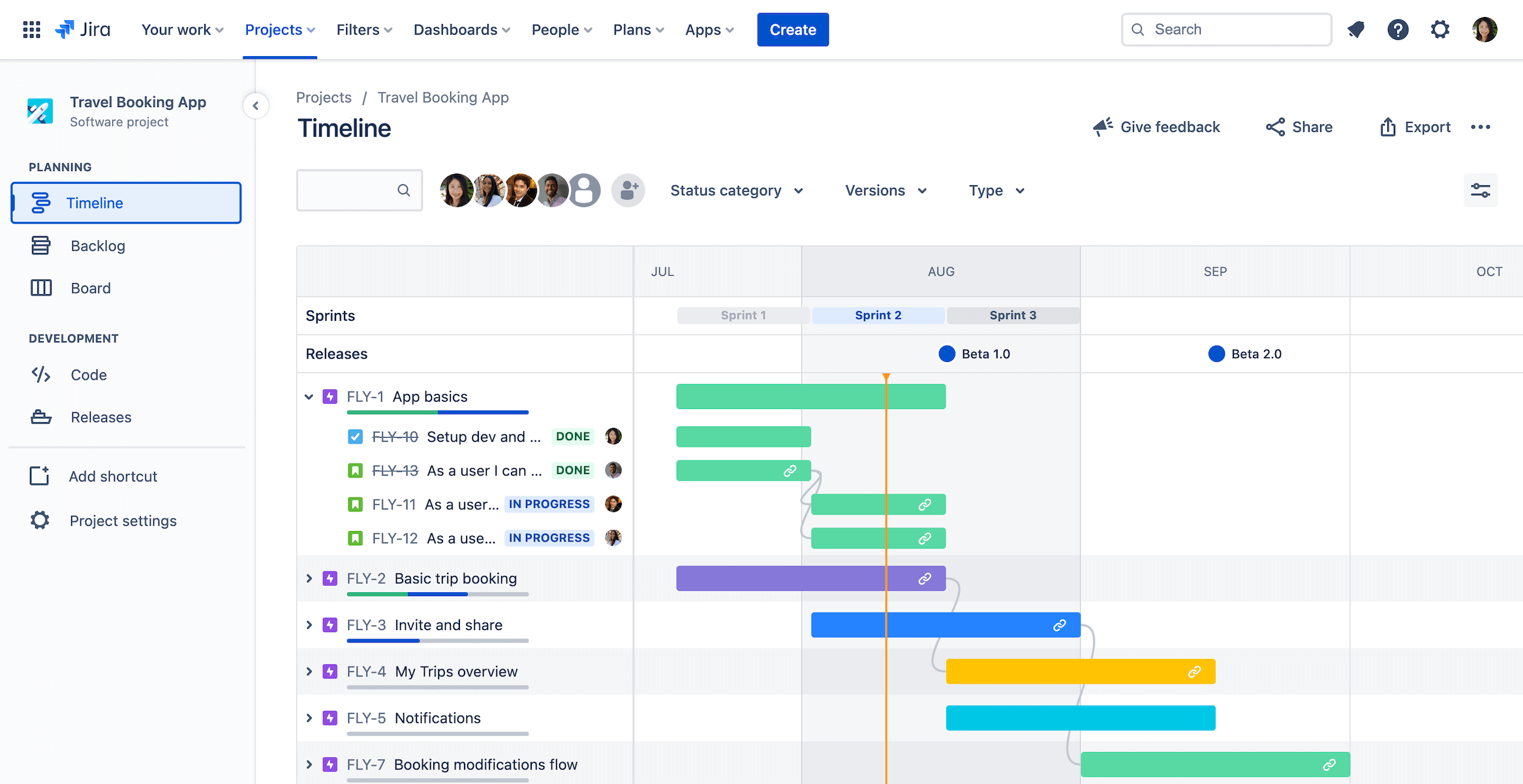
In Jira Software, all the team's work, including items on the product backlog, is visualized on the timeline. This level of transparency makes it easier for the team to make decisions on current or future work. The timeline in Jira also helps teams manage dependencies and track progress on the big picture in real-time. Keep in mind that agile is not about creating limitations with rigid plans but staying flexible about the path you take to create a successful sprint cycle and deliver value to your customer. Jira has dozens of free templates to help you get set up quickly.
Ensuring that project information remains up to date without tasking your team with additional work can be challenging. Luckily, there is an easier way with automation in Jira. With a no-code rule builder, teams can automate their processes with a few clicks. In addition, automation in Jira is entirely customizable and allows your team to set up rules to suit their specific needs to save time and keep Jira up to date.
Some examples of rules include:
- When your last sub-task closes, then close the parent issue.
- When a bug fix is shipped, then close all issues and notify customers.
- When a customer raises an issue, create a cloned issue and assign it to an engineer.
To help your team get started quickly and hassle-free, Jira Software includes sample automation rule templates built around common use cases.
While Jira Software hustles to help your team work better together, it’s important to share progress, results, and decisions with team members and stakeholders. The place where knowledge and collaboration meet is where Confluence shines. Get started by creating a Confluence page using the Jira Report template. Select the project you’d like to report on, and the template will automatically create a preconfigured status report page. The report will automatically display pie charts based on your Jira project’s fields such as priority, issue type, and more.
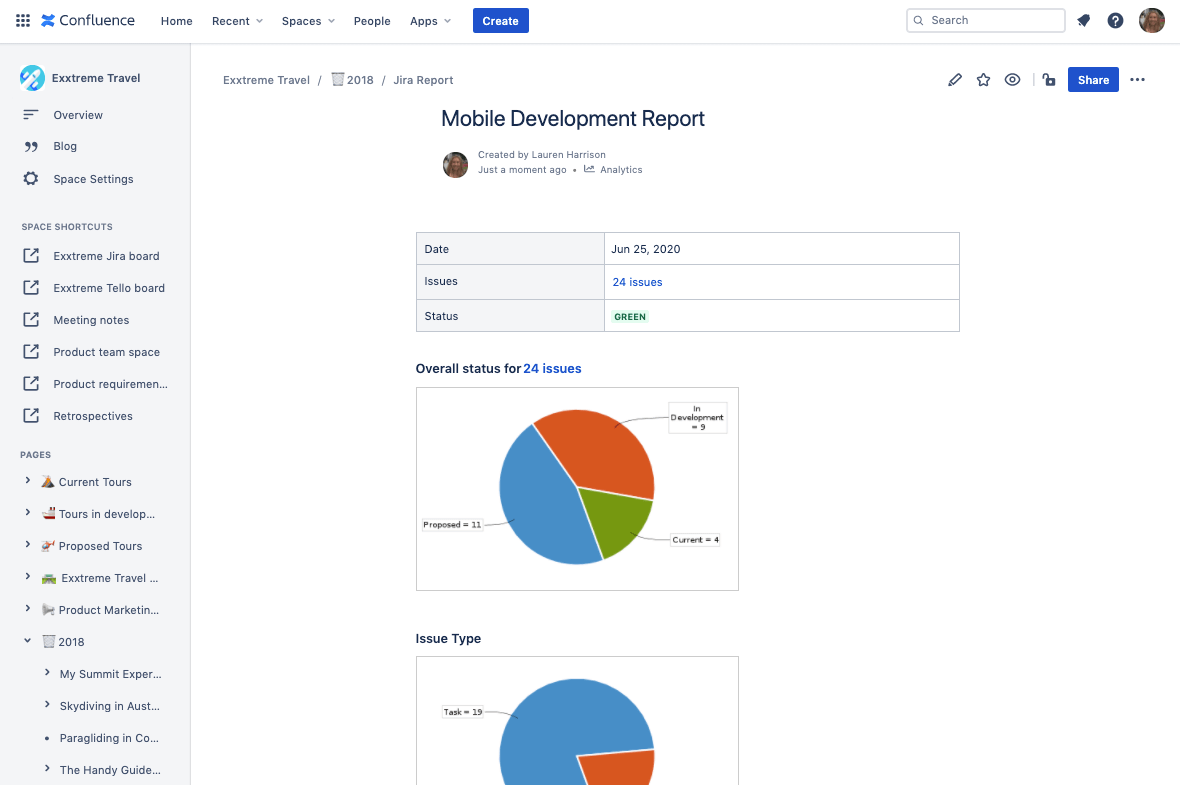
As you can see, there are endless ways in which Jira and Confluence complement each other, especially during the refinement stage. Confluence gathers your team's ideas, plans, reports, and knowledge while Jira tracks your issues and workflow. Your team can feel confident knowing that the two applications will work together to help them get the job done.
As your team begins to implement agile processes and tools over time, the customization will naturally foster itself to adapt to your team’s needs. We hope that your team will experience the incredible benefits of using Confluence and Jira to manage agile projects with organized workflows, task tracking, and integrated document management.
Ready to sprint towards your team’s full potential? Get started with Confluence and Jira Software.
